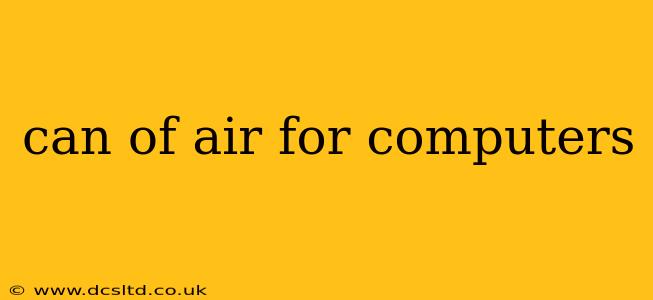Dust accumulation inside your computer is a silent killer, leading to overheating, performance issues, and even hardware failure. A can of compressed air, also known as canned air, is your first line of defense against this insidious threat. This comprehensive guide will explore everything you need to know about using canned air for your computer, addressing common questions and concerns.
What is Canned Air Used For in Computers?
Canned air is a propellant-based spray that blasts a high-velocity stream of air, effectively removing dust and debris from hard-to-reach areas within your computer's components. This simple yet powerful tool is crucial for maintaining optimal performance and extending the lifespan of your PC. It's used to clean:
- Fans: Dust buildup on fans drastically reduces their efficiency, causing overheating.
- Heatsinks: Similar to fans, heatsinks need to be free from dust to effectively dissipate heat.
- Internal Components: Motherboard, graphics card, RAM slots, and other internal components benefit from regular dust removal.
- Peripherals: Keyboards, mice, and other peripherals can also accumulate dust and benefit from a blast of compressed air.
How Often Should I Use Canned Air on My Computer?
The frequency of cleaning depends on your environment and usage. If you live in a dusty area or have pets, you might need to clean your computer every few months. For those in cleaner environments, once or twice a year might suffice. Listen for unusual fan noise: This is often a key indicator that it’s time for a cleaning. Visually inspecting your computer's interior can also help you determine the need for cleaning.
What are the Different Types of Canned Air?
While most canned air is functionally similar, there are a few key differences to consider:
- Propellant: Some use environmentally friendly propellants like HFC-134a, while others may utilize less sustainable options. Check the label for details.
- Static Discharge: Some cans include anti-static agents to minimize the risk of electrostatic discharge (ESD) damage to sensitive electronics.
- Reach: The nozzle design and length can affect how well you can reach tight spaces. Look for cans with extendable nozzles or flexible straws.
Can I Use Canned Air Upside Down?
This is a common question. Generally, no, you shouldn't use canned air upside down. Using it upside down can release liquid propellant, which can damage your computer components. Always use it upright, as directed on the label.
Is Canned Air Harmful to My Computer?
When used correctly, canned air is not harmful to your computer. However, using it improperly, such as spraying too close or using it upside down, can cause damage. Always maintain a safe distance (about 6-8 inches) and spray in short bursts to avoid excessive pressure.
What are the Best Practices for Using Canned Air on My Computer?
- Power Down: Always power down your computer and unplug it before using canned air.
- Ground Yourself: To prevent static electricity damage, ground yourself by touching a grounded metal object before starting.
- Safe Distance: Maintain a safe distance (6-8 inches) between the nozzle and your components.
- Short Bursts: Use short bursts of air rather than continuous spraying.
- Angle of Approach: Direct the air flow along the component’s surface, rather than directly into any small openings.
- Ventilation: Work in a well-ventilated area to avoid inhaling the propellant.
Can I Use Other Cleaning Products Besides Canned Air?
While canned air is ideal for removing dust from hard-to-reach places, you can also use a soft brush (like a paintbrush) to gently remove dust from accessible areas. However, avoid using liquids or any cleaning solution inside your computer unless specifically recommended by its manufacturer.
By following these guidelines and using canned air responsibly, you can effectively maintain the cleanliness and performance of your computer, significantly prolonging its lifespan. Remember, regular maintenance is key to preventing costly repairs down the line.
